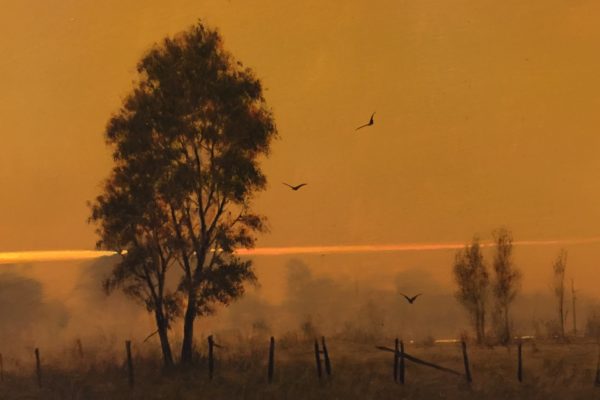William R. Davis, DAY’S END, oil on panel, 9 x 11 3/4 inches (12 1/2 x 15 1/4 inches framed), $5,000
William R. Davis has built his highly successful career around emulating the styles and techniques of 19th-century American marine and landscape artists while following his own vision: It’s almost as if he were of their time and mentality.
Essentially a self-taught artist, Bill initially mastered the approach used by such Luminists as Martin Johnson Heade and Fitz Hugh Lane. (“Luminism” denotes a style of painting characterized by crystalline light, attention to detail and a satin-smooth surface devoid of obvious brushstrokes.) A few years ago, however, he began moving in a somewhat different direction, looking back to the Tonalist style popular with American artists from the 1880s until about 1915. George Inness, James MacNeill Whistler and Dwight Tryon are among the artists associated with this approach, derived from the French Barbizon school and defined by a pervasive atmospheric color and distinctive mood.
Bill first paints his skies and lets them dry. The actual subject matter comes later — as it did with “Day’s End,” a sunset in the hazy heat of summer. “It could have been a yachting scene, but that day I got up and decided I was going to paint trees,” he says. The sky’s orange glow suffuses the whole scene as if the very air were bathed in dusky color. The idea for the steak of light piercing the sky came from a painting by John J. Enneking, a Boston artist who sold a great many sunsets in his time.
While Bill seeks to paint works resembling 19th-century landscapes in look and feeling, he never copies work. Nor does he generally paint actual locations. “Almost all my paintings are made up,” he says. “I like to paint something that’s almost surreal, like a moment in time. I like paintings that make me feel like they suddenly put you someplace.”
The dilapidated rail fence certainly helps establish a strong sense of place in “Day’s End.” “I love old fences,” Bill says. He compares them to the crumbling ruins — such as castles, towers and statues — in many romantic 19th-century landscapes. “It makes you understand someone used to live there.”
Bill also frequently includes crows in his paintings. “It’s like a second signature, I use it so often,” he says. Although each of the birds here is defined merely by two expert flicks of the brush, the V-shaped marks suggest a living presence within the scene. Maybe we imagine a haunting caw or two breaking the evening’s silence. Or maybe — as we “watch” the crows circling overhead — our spirits soar a bit, too. View more paintings by William R. Davis

